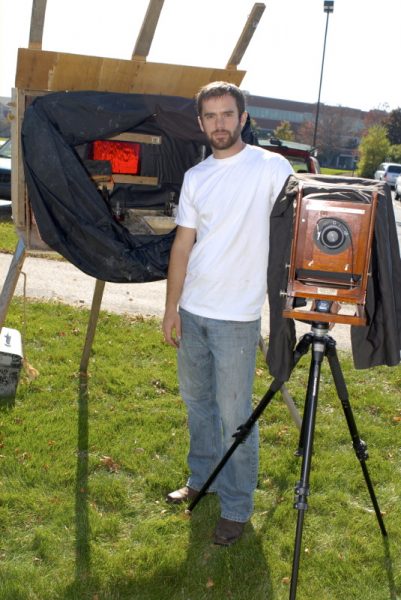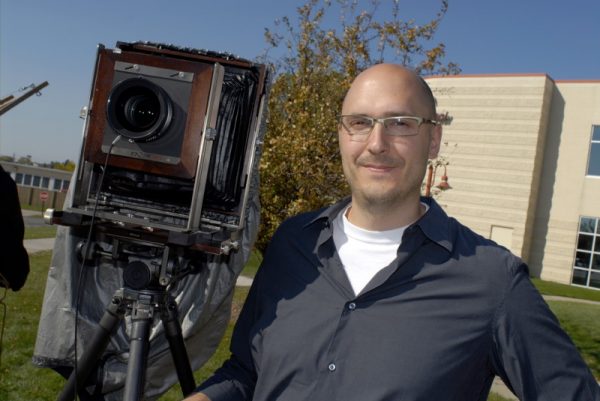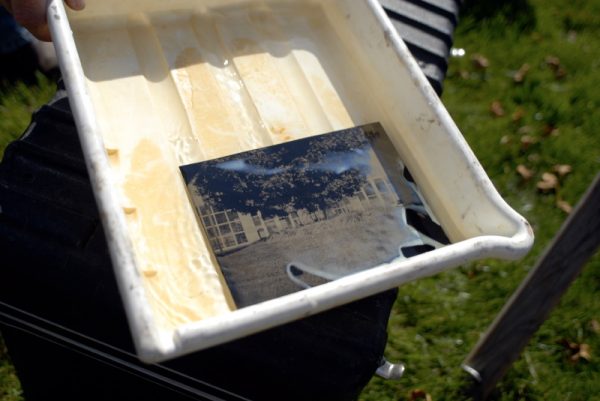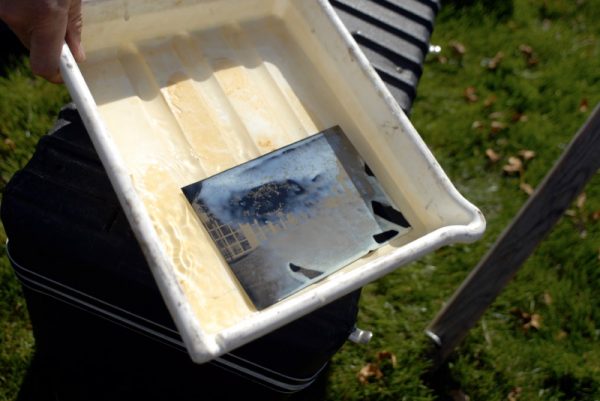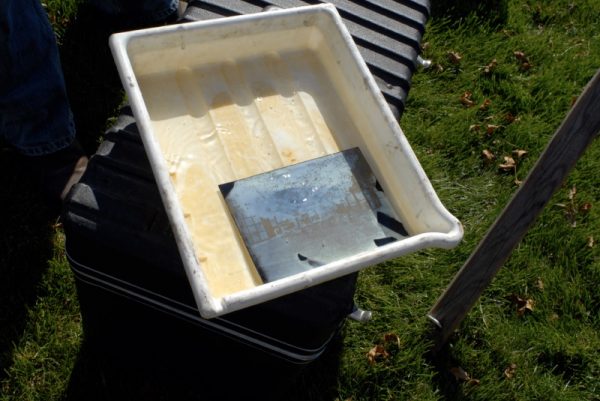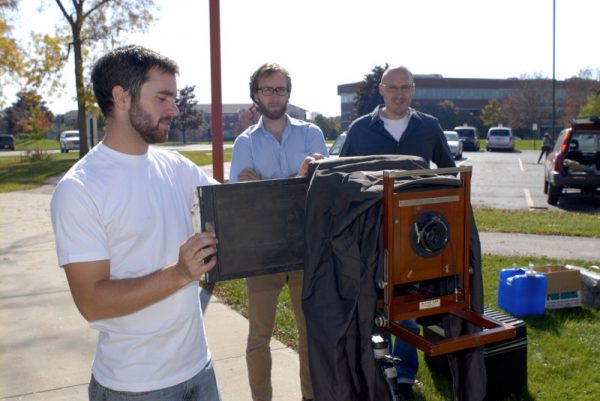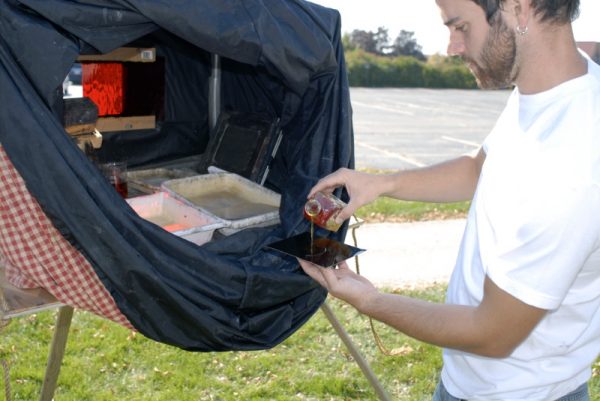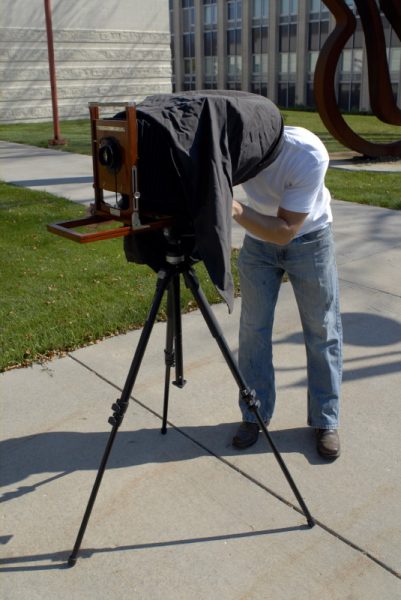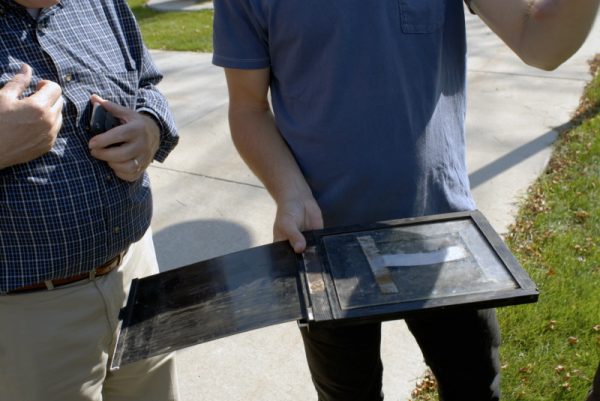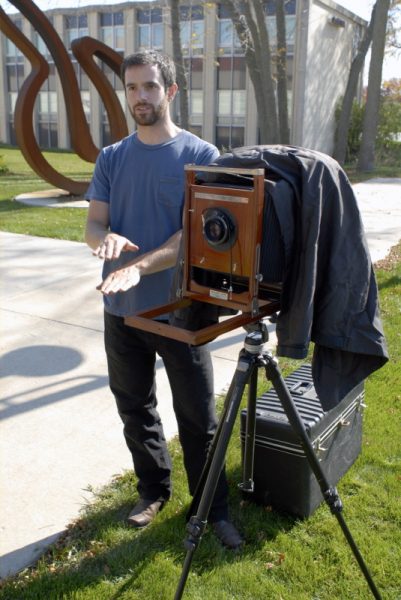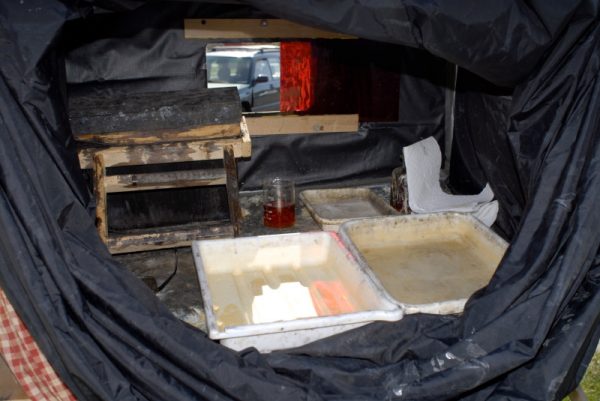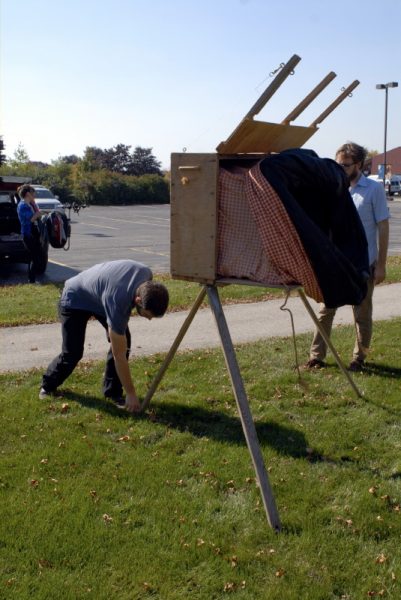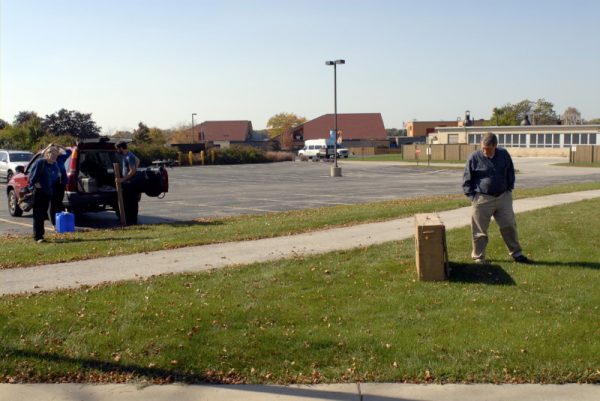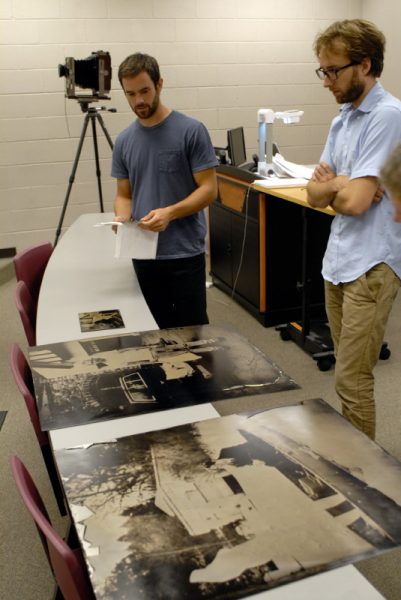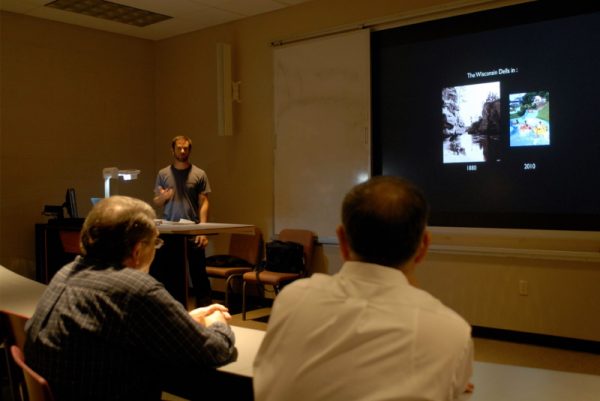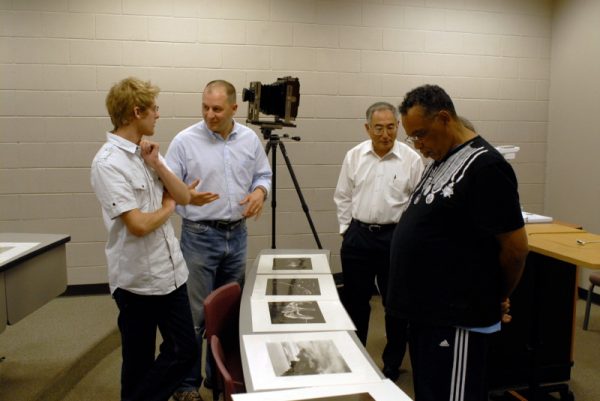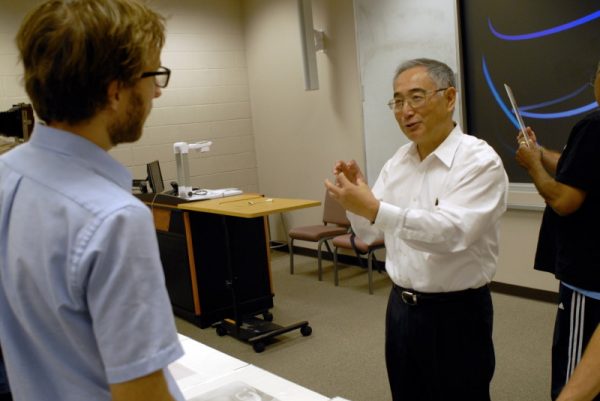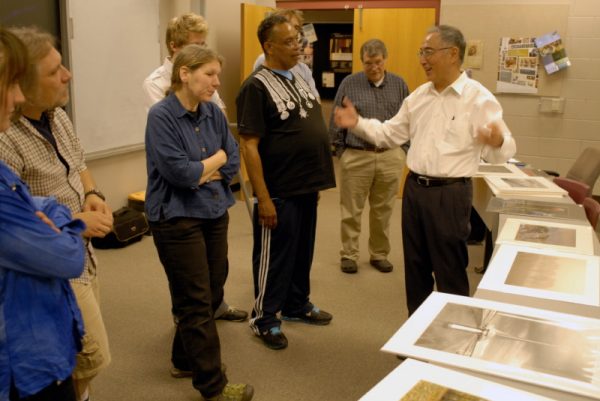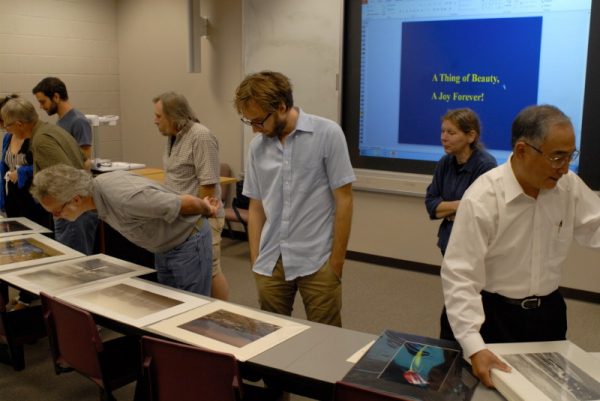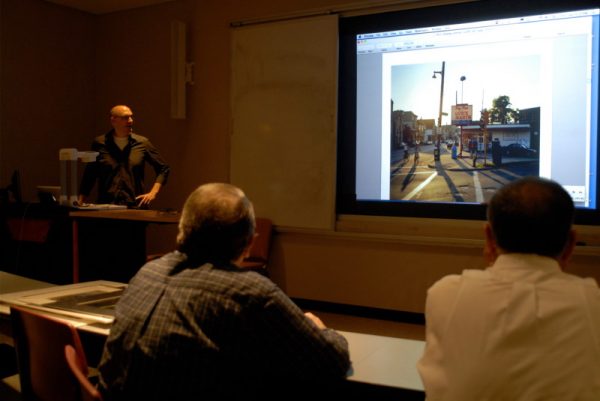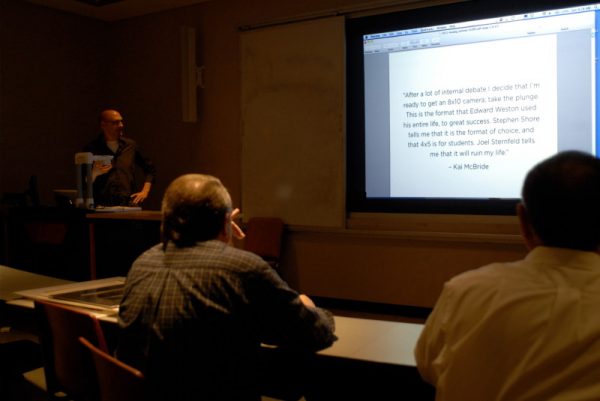Today’s Analog Photo Seminar was a real treat. Three large-format photographers talked about their personal journeys in photography, the creative process, and developing their values through their method of photography. There were not as many attendees as hoped for, but those in attendance – local photographers and students from Cardinal Stritch University – were interested and enthusiastic. As with previous workshops, Tim Abler and the Photography/Art Department of Cardinal Stritch University were generous enough to donate the multi-media room for the workshop. Each photographer presented on their work over the morning, from 9:15a till 12:30p. After a short lunch, break two of the photographers came back and we all stepped outside for some demo-photography with the photographers.
Mark Brautigam spoke primarily about his self-taught journey in photography — from the Marines, to living in California, to coming home to Wisconsin –and about his currently-receiving-some-well-deserved-attention body of work, “On Wisconsin.” Mark listed his big influences as William Eggleston, Stephen Shore, and Richard Misrach, with a big influence from Joel Sternfeld. In considering whether to get a 4×5 camera or 8×10 camera, Mark looked to his photo-heroes and saw many were using 8×10 cameras. Then, after helping a friend set-up an 8×10 camera, Mark made his decision—it was 8×10 for him!
Also on this topic, Mark shared a great quote with us: “After a lot of internal debate, I decide that I’m ready to get an 8×10 camera, take the plunge. This is the format Edward Weston used his entire life. Stephen Shore tells me it is the format of choice and 4×5 is for students. Joel Sternfeld tells me that it will ruin my life.”-Kai McBride.
Working on his “On Wisconsin” images gave Mark a “reason to explore WI,” his home state, which he thinks, in the past, he may have not given the visual consideration it deserves. Finding the proper direction for his project took a long time, as Mark said, “It took me years to figure out what I was doing with the project.” He would set off on road-trips with no pre-determined destination, letting the roads and the light guide him to his next subject. He learned too though, that knowing when to end the project was equally challenging. As Mark said, “You don’t know when to end a project until you’re done with it”, suggesting that he “just knew” when the project was at its finish.
Regarding his images…
-Wally Mason, of the Haggerty Museum, describes Mark’s images as “paragraphs”, meaning they tell more than the basic information of a scene to a viewer, but still require the viewer to fill in a lot of the visual “story.”
-Mark’s film of choice is Kodak Portra 160, a low-ISO color-negative film.
-He’s now seeking a publisher who might like to release “On Wisconsin” as a photo-book.
-Mark’s work is often compared to another photographer named Alec Soth, who coincidentally was taught by Joel Sternfeld, one of Mark’s favorite photographers.
– – – – –
The second speaker of the day was Dr. Yong-ran Zhu . Dr. Zhu emigrated from China to the US 25 years ago When he arrived he could read English, but not speak it. Being as driven as he was, Zhu set about learning English and computer science. He was very driven by his work, but learned in time that the intensity of his work was stressing him too much and realized he needed to find an outlet to relieve his stress. He became familiar with the work of Ansel Adams; Adams’ dedication to craft and strict discipline rung well with Zhu. He began learning how to make “perfect” negatives and prints by training with John Sexton and has been winning awards for his landscape and still-life photography (color and B+W) ever since.
His studies in photography progressed quickly and Zhu was so taken with photography that he soon wrote an article entitled “Relieve Stress With Photography” which saw publication. From listening to Zhu, it is apparent that he found much deep philosophy in photography…
-a photographer “needs to see (a) childish (view of the world)”, to see with wonder and awe and joy.
-“Large format makes you look more carefully”.
-“need to see light and to pre-visualize your image—no snapshots!”
-He believes Adams’ photos are “unified by light”.
-“the photographer has to go out and keep adding to their understanding and feelings. There is not short-cut.”
-to succeed, a photographer needs “inspiration, technique, and craft.”
-“There are no unworthy subject, only unwilling photographers”-Ruth Bernhard
-“When you first approach something to photograph it, be still with yourself until the object affirms your presence…you don’t go looking for photos – the subject should “grab” YOU.”
-regarding development of your photo-skills: “Read, Apply, Self-critique, Slow down your shooting, See more, Analyze the results, Go back and do more.
-regarding “composition”, Zhu shared a quote from Stieglitz: “Everything in a photo should have a reason for being there.”
-it’s up to the photographer to “see harmony in the world. Photographers look for relationships, while snap-shooters look for things.”
– – – – –
The final presenter of the morning was Nick Olson, a fine-art photographer working with the collodion wet-plate method. Nick studied with John Shimon and Julie Lindemann at Lawrence University and received his MFA from the Cranbrook Institute. He spent two summers assisting with John Coffer, the photographer recognized for reigniting the fascination with wet-plate photography.
His experience on Coffer’s farm led Nick to really slow down and investigate things when he is getting ready to photograph something. He compared the approach to one his tasks on the farm–chopping wood. Nick was responsible for a large amount of wood-chopping. When doing the same task over and over, Nick began to see the task differently, to notice more, and to see the task in a “different light.” He then began to apply this approach to photography—by getting so familiar and invested in the process of making an image, that it made him pay much more attention to what he was photographing. As he put it,” Investing time in the process affects the outcome.”
Once he became adept with the wet-plate process, Nick created a series of images around the topic of tourism. He looked at old photos from H. H. Bennett in the Wisconsin Dells and then made photos contrasting the way people interacted with the natural world in the late 1800s with the way modern tourists interact with manufactured environments that are inspired by the natural world, but offer a much more “managed” or controlled experience.
Nick has also been creating portraits with this process. As his working method is “alternative”, he also seeks to find portrait subjects who are also pursuing a simpler, or “off the grid” lifestyle.
-Nick said the approximate sensitivity of the wet-plate emulsion is “almost zero”!
-On a bright, sunny day, at f9-f11, the exposure can last 1-4 seconds.
– – – – –
After a short lunch break, Mark and Nick both set up their cameras outside the Communications/Fine Arts Building. All the participants got to look through Mark’s 300mm lens on his Ebony 8×10 field camera, noting how shallow the depth-of-field is on such a massive format. Nick set up his coating/developing booth and camera, treating us to a demonstration of the wet-plate method. It was really amazing!
– – – – –
The workshop was done by 2:30 and everyone went home feeling much inspired by the work of these three very uniquely talented photographers–Mark Brautigam, Dr. Yong-ran Zhu, and Nick Olson. All three photographers work with large-format cameras, and could hardly be working in more different methods. It was thrilling to see their work and to hear them talk about it. Thank YOU, Mark, Dr. Zhu, and Nick!
